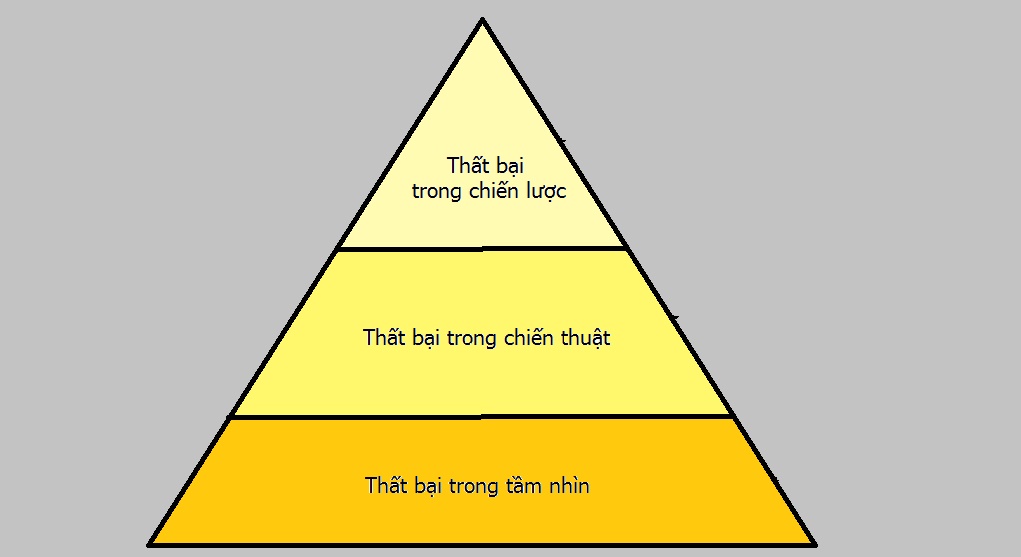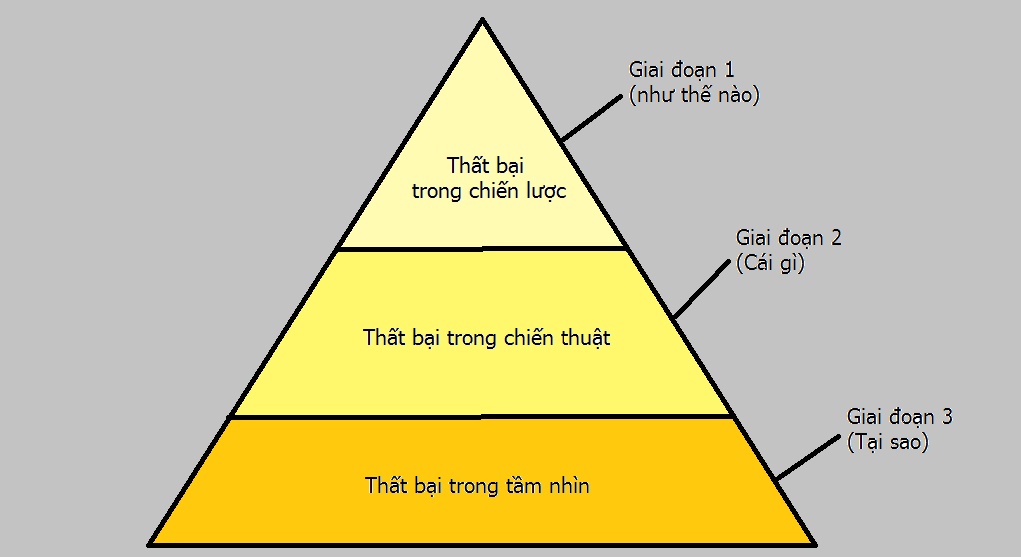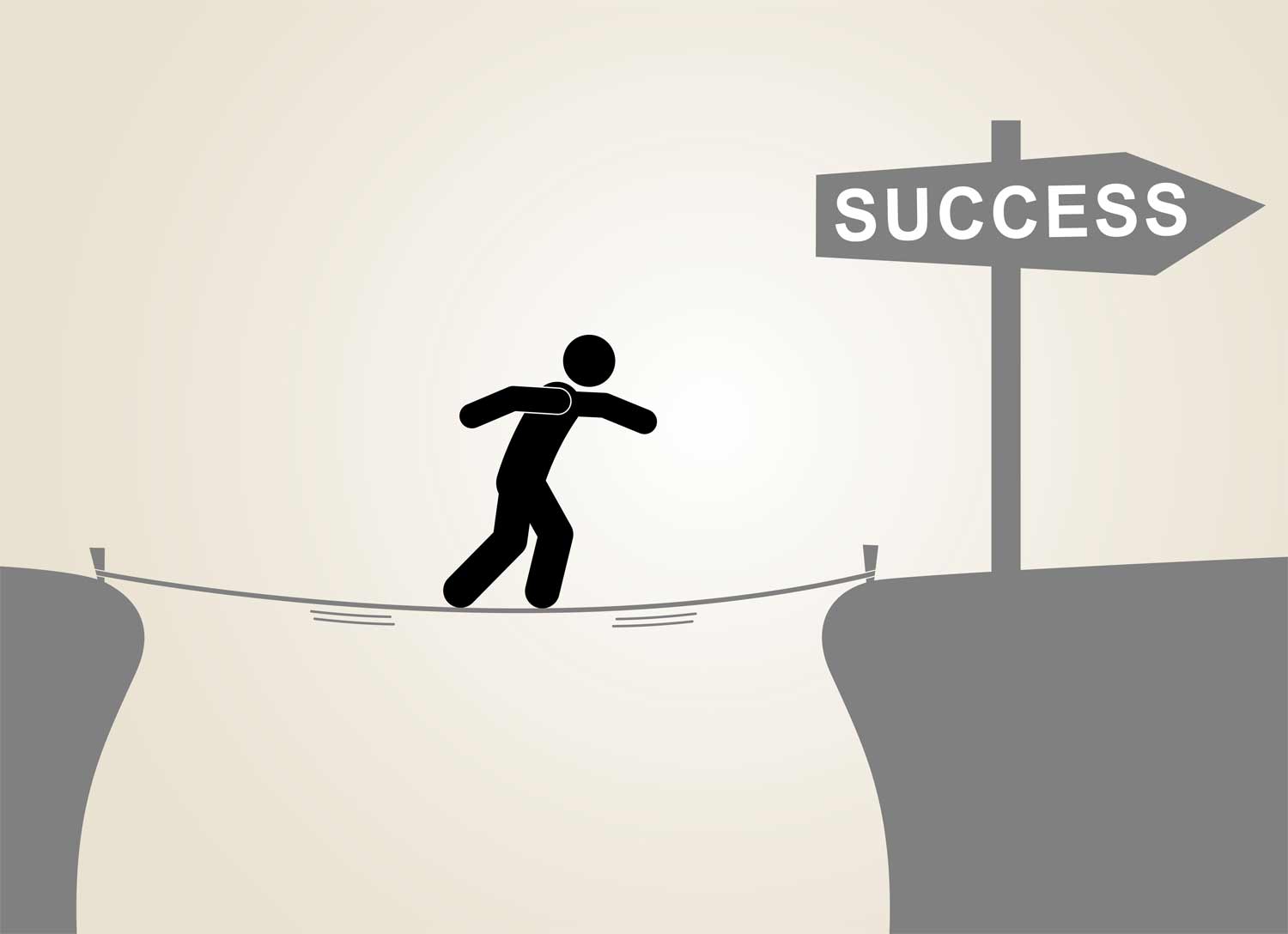3 stages of failure in work and life
One of the hardest things in life is to know when to continue and when to skip something to turn in another direction.
On the one hand, perseverance (perseverance) and persistence (grit) are two core things to achieve success in all areas. Anyone who wants to be a "master" in their profession will have to face moments of doubt and in one way or another will have to seek the spirit of determination from within themselves to can move forward. If you want to build a successful company or get a great marriage or conquer a new skill, then "continue to pursue that goal even when in trouble" is probably the quality The most important thing every person should have.
On the other hand, advising a "never give up" is a "terrible" advice. Those who succeed - they give up constantly. If something doesn't work or doesn't happen, the smart person doesn't do it over and over again. They look. They adjust. They change direction, then they give up again. It's like a saying by Einstein that "Doing the same thing over and over but looking forward to getting different results is a crazy thing."
Life requires both strategies. Occasionally, you need to show a confidence that nothing can shake and maximize your efforts. Sometimes, you need to give up things that don't work and try something new. The important question here is: how do you know when to give up and when do you need to continue to do it?
One way to answer this question is to use a framework that I call "3 Stages of Failure" - 3 stages of failure.
3 stages of failure

This framework will help you clarify everything by dividing challenges into 3 stages of failure:
- Phase 1 is a failure of strategy (Failure of Tactics) : How wrong this is (How) . They happen when you cannot build a solid, not measuring and lazy system in a detailed description. The failure of the strategy is a failure to implement a good plan and a clear vision.
- Phase 2 is the Failure of Strategy . This is exactly what that mistake is (What) . They happen when you follow a strategy but don't achieve the results you want. You may know why you are doing what you do and you know how to do it but still choosing the wrong thing can help what you want to be a reality.
- Stage 3 is failure in vision (Failure of Vision) . This is the reason why it appears wrong (Why) . They happen when you don't have a clear direction for yourself, pursue a vision without making you feel satisfied or don't understand why you're doing what you did.
In the rest of this article, I will share with you a story, a solution and a short summary for each stage of failure. My hope is that this framework of "3 stages of failure" will help you make the difficult decision that when to give up and when to continue fighting it. Although it is not a perfect solution, I hope you will find useful things.

Stage 1: Failure in strategy
Sam Carpenter became the boss of a small business in 1984. By using $ 5,000 as a prepayment, he bought a company that was in a difficult time in Bend, Oregon and named it. is Centratel.
Centratel provides 24/7 phone answering service for doctors, veterinarians and some business operators who need phones to be picked up all the time but cannot afford to pay for more people. return to work directly at the office. When buying this company, Carpenter hopes that the Centratel "will one day become the best quality answering service provider in the US".
However, everything happened not as expected. In an interview in 2012, Carpenter described the first 10 years of his business as follows:
"Exactly, I worked 80 to 100 hours a week for 15 years. Believe it or not, I am a single father with two children. I have tried all kinds of antidepressants. feel and more.I don't have enough money to pay staff salaries and may lose my company.If you can imagine a useless man, a disabled person and then, multiply it is 10 times bigger than that is who I am. It really is a terrible time. "
One evening, just before the time to pay salary for staff, Carpenter realized something that he never thought about before. His business was difficult because it completely lacked the necessary systems to achieve maximum productivity. He said: "We face enough problems because people are doing the way they think is the best."
Carpenter explains, if he can complete these systems, his employees can focus on the most important parts every day instead of constantly spending time on petty matters. Immediately, he began to outline the step-by-step paper for his business.
"For example," he said, " we have a 9-step process for answering the phone at the reception desk. Everyone does it this way. This is the best 100% way to do it. We have one. Organic system, turning it into a mechanism and making it perfect ".
Two years later, Carpenter continued to record and modify every process in the company. How to create a sales presentation, how to deposit money in a bank by check, how to pay a bill to a customer, how to handle payroll . He built it build a manual that any employee can read and apply according to the rules and procedures that have been set up, for each system one step by step.
What happen?
Carpenter's work week dropped quickly from 100 hours to less than 10 hours per week. He no longer had to deal with every emergency because there was a set of procedures to guide the staff to deal with those situations. As work quality improves, Centratel has increased the service fee and the company's profit margin has increased by 40%.
Today, Centratel has grown to about 60 employees and recently celebrated its 30th anniversary. Currently, Carpenter only works 2 hours per week.

How to fix failure in strategy
Failure in strategy is the problem of "HOW" - how . In the case of Centratel, they had a clear vision (to become the best quality telephone answering service in the US) and a good tactic (the market needed electrical answering services). open voice). However, they do not know how to implement that strategy and vision.
There are 3 ways to fix failure in strategy:
- Record the process.
- Measure the results obtained.
- Review and adjust strategies.
Record the process: McDonald has more than 35,000 sales locations around the world. Why can their new employees "plug in and run" while still selling only one product? Because they have a "deadly" system suitable for each process. Whether you're running a business, taking care of your family or managing your own life, building great systems is crucial for repeated successes. It all starts with outlining each step-by-step paper for each process and developing a checklist (a list of reminders, marking up completed or not) that you can track when everything happening unexpectedly.
Measure the results: If there is something important to you, measure it. If you are an entrepreneur, measure how many sales calls you make every day. If you're a person who likes writing, measure how often you publish a new article. If you are a weightlifting athlete, measure how often you practice. If you have never measured the results, how do you know if your strategy is feasible?
Review and adjust strategies: The most exhausting thing about failures in phase 1 is that they never stop. The commonly used strategies will become obsolete. Strategies that used to sound very bad can now become a good idea. You need to constantly review and improve the way you work. Successful people often abandon strategies that cannot make tactics and vision move forward. Fixing failures in strategies is not a one-time job but it must become a lifestyle.
Stage 2: Failure in tactics
In March 1999, Amazon founder Jeff Bezos announced that his company has launched a new service called Amazon Auctions to help people sell "almost everything on the Internet". . This idea created something that could compete with eBay. Bezos knows there are millions of people with lots of goods that want to sell and he wants Amazon to become the place where these deals are made.

Greg Linden - Amazon software engineer at the time remembered this project as follows: "This is really a very heavy task. Everyone in the company has to stop the projects of they are focused on it, all pages Auctions with all the same features as eBay and more are built from where nothing is. It was designed, created, developed, tested and started in less than 3 months ".
Amazon Auctions is a failure that attracts many people's attention. Only 6 months after its launch, management realized that this project was nowhere near. In September 1999, they moved on to a new proposal that converted the idea of creating an online auction company into Amazon zShops - allowing everyone from big companies to individuals to Create online stores and sell goods through Amazon. Once again, Amazon fluttered and failed. To this day, neither Auctions nor zShops exist. In December 2014, Bezos mentioned his unrealistic projects with the famous saying: "I have created billions of dollars for failures at Amazon.com. That's a billion."
Undeterred, Amazon tried again by creating a platform for sales associates with third parties (Third-party sellers). In November 2000, they launched Amazon Marketplace to allow individuals to sell used goods in addition to the site's new products. For example, a small bookstore might include read books and new books from Amazon.
The project was successful and by 2015, Amazon Marketplace has accounted for nearly 50% of the total $ 107 billion in sales at Amazon.com.
Fix failure in tactics
Tactical failure is the problem of "WHAT" - what . In 1999, Amazon had a clear vision of "becoming a central company that attracts the most customers." They are also "masters" in making everything happen and that's why they can launch Amazon Auctions in less than 3 months. "Why" and "how" have been controlled but "what" is still unknown.
3 basic ways to fix tactical failure:
- Start working quickly.
- Making it cheap.
- Quick review.
Work on it quickly: Some ideas are much more feasible than other ideas, but no one really knows if those ideas will come true unless try them. No one knows the future - including venture capitalists, including those considered smart at Amazon, including your friends or family members. All research, design and planning are just what is outlined on paper. I really like a saying from Paul Graham: "You don't really start working [with your idea] until you start working on it."
Because of this, the key point is to get the strategies fast. The sooner you test a tactic into practice, the faster you will get feedback whether it is feasible or not. Be aware of Amazon's time points: Amazon Auctions launched in March 1999, Amazon zShops launched in September 1999 and Amazon Marketplace launched in November 2000. Three great efforts in just 20 months.
Make it cheap: Assuming that you achieve a minimum level of quality, the best thing here is to not invest too much money to test new tactics. Losing a "cheapest" way will increase your chances of succeeding because it means you can try more ideas. In addition, doing cheap things will also create conditions for other important purposes. It will keep you from sticking to a particular idea. If you invest too much time and money in a particular tactic, it will be difficult to completely abandon that strategy. The more energy you invest in one thing, the more you feel "ownership" gives it more. Bad business ideas, malicious relationships and all negative habits will be difficult to remove once they become part of your identity. Test new "very cheap" ideas to avoid these pitfalls and increase the chances that you will pursue a better strategy than pursuing a strategy that you invest the most.
Quick review: The default tactics need to be reviewed and adjusted. You find it difficult to find a successful entrepreneur, artist or creator - who is currently doing exactly the same thing the moment they start. Starbucks sold coffee and espresso machines more than a decade before they started. 37 Signals started as a web designer before changing the direction to become a software company worth more than $ 100 million today. Nintendo has produced cards and vacuum cleaners before "stealing the heart" of millions of video game fans worldwide.
Too many entrepreneurs think that if the first business idea is a failure, they are not able to do it (without a claim to that). Too many artists believe that if the first role does not receive praise, they do not have the appropriate skills for this job. Too many people believe that if one or three first relationships are too bad, they will never find true love.

Imagine if the forces in nature work in this way. What if "Mother Nature" is only for me once to create life? At that time, we were all single-celled bodies. Fortunately, this is not the way evolution takes place. For millions of years, life has been adapted, evolved, modified and repeated until it reaches the diversity and abundance of species - creatures that currently live on the planet. Solving / clarifying all problems only in the first attempt is not the natural process of creation.
So if your initial idea is a failure and you feel like you're constantly reviewing and adjusting it, allow yourself to rest. Change your tactics very normally. That's the way the world exists. You have to focus on what you want, not to be distracted from your pursuit by comparing the views or successes of others.
Stage 3: Failure in vision
Ralph Waldo Emerson was born in 1803 in Massachusetts. His father was a pastor at the Unitarian church - a relatively popular branch of Christianity at that time.
Like his father, Emerson also attended Harvard University and became a priest. However, he realized that he himself did not agree with many teaching positions at the church after a few years of working there. Emerson expressed a strong disapproval of the church leaders before making a decision: "The way this church respects the Lord is not suitable for me and this reason is enough to force me to leave. it".
Emerson left the church in 1832 and spent the following years traveling around Europe. The new journey explores imagination and helps him build good friendships with many contemporary philosophers and writers like John Stuart Mill, William Wordsworth, Samuel Taylor Coleridge or Thomas Carlyle. It was written that his travels to Paris flashed "a moment of intense emotions of visionary ability that helped him to abandon theology and towards science".
After returning to the United States, Emerson founded the Transcendental Club consisting of a group of intellectuals like him to discuss philosophy, culture, science and the way to improve American society.
There are still puzzling questions about Emerson's life and values when he started his career as a pastor, then made trips around the world and continued to participate. Transcendental Club meetings to realize your dream of becoming a philosopher and writer. He spent the rest of his life pursuing independent ideas, essays and books that are still valid today.
Fix failure in sight
Failure in the vision is the problem of the word "WHY" - why. They happen because your vision or goal for what you want to become (your reason) does not match the actions you are taking.
There are 3 basic ways to fix failures in sight:
- Carefully review your life.
- Clearly identify the unshakeable thing in you.
- Control criticism.
Carefully consider your life: Rarely do we take the time to seriously think about our vision and values. Certainly, it is not a requirement to say that you must develop a personal vision of your own work or life. Many people are willing to follow the will of the people or the crowd to abandon the predetermined plan and live the way "what comes will come". In theory, this is fine. However, in reality, there is a problem:
If you never decide the vision of your life, you will often find yourself living with someone else's dream.
Like the children, Emerson followed his father's career, attending Harvard University and doing the same job before realizing it was not what he wanted. Think of others' vision as yours - whether it comes from family, friends, celebrities, bosses or society - will not bring you to the dream you want.Your identity and your habits need to be matched.

Because of that, you need to take the time to think carefully about your life. What do you want to accomplish? What do you want to spend the days of your life doing? No one has a duty to clarify your vision for you. That is the task you have to do. My suggestion is to start by exploring the core values of your life. Then, review recent experiences by writing an Annual Review or making a very objective report.
Clearly identify the unshakeable thing about you: Something "unshakable" is something that you are not willing to let it be shaken, no matter what happens. One common mistake is that we can easily create an unshakable tactic, while it should have been a vision. Being attached to personal opinions is too easy. But when you are obsessed with something, you will be obsessed with your vision, not your opinion. Be strong in your vision , not the "special version" of any idea. As Jeff Bezos once said: "We are determined in our vision but we are flexible in the details."
The key here is to realize that almost everything is detailed - your strategy, your strategy and even your business model. If your "unshakable" is to become a successful entrepreneur, then you will have a lot of ways to achieve that vision. If "Amazon's unshakable" is "becoming a company that attracts the most customers" then they could lose billions of dollars for Amazon Auctions, Amazon zShops and still achieve their goals.
Once you are confident with your vision, it is rare for you to lose it all at once. Some mistakes that happen can ruin your entire dream. More likely, you will not succeed at the tactical level and feel broken. This will cripple your efforts and enthusiasm and you will give up not because you should, but you feel that you have to. Your emotions make you move from failure in stage 1 or 2 to failure in stage 3. Most of the mistakes that people think are failures in vision are indeed, that is failure in tactic. Many entrepreneurs, artists and creators put great faith in their ideas and when that idea cannot be realized, they also give up their vision. Don't develop a sense of "possession" of wrong things. Nearly countless roads can achieve your vision if you are willing to be flexible in every detail.
Control criticism: Criticism can be seen as an indicator of failed tactics and strategies, however - assuming you are a rational person with feasible goals it is rarely just newspaper of a failed vision. If you are committed to forming a vision as an "unshakable" element in your life and not giving up right from the first attempt then you must be ready to control criticism. You do not need to apologize when you are passionate about something but must learn how to deal with hateful people.

The fourth stage of failure
The fourth stage of failure not mentioned above is the opportunity failure.
These are the mistakes of "WHO" - who. They happen when society cannot provide fair opportunities for everyone. Opportunity failures are the result of many complex factors: age, race, gender, income, educational background and more.
For example, there are thousands of men my age who live in slums in India or on the streets of Bangladesh - people who are smarter and more talented than me. But our lives are very different, largely because the opportunity to come to each person is so different.
There are many things that each of us can do as individuals or societies to reduce those opportunity failures. Tuy nhiên tôi không chọn tập trung vào nó ở đây bởi vì các thất bại này rất khó tác động. Trong khi đó, tầm nhìn, chiến thuật và chiến lược của bạn là tất cả những thứ mà bạn có thể kiểm soát trực tiếp.
Conclusion
Hy vọng rằng, bộ khung 3 giai đoạn của sự thất bại sẽ giúp bạn làm rõ những vấn đề mà bạn đang phải đối mặt và biết cách giải quyết chúng. Một thứ có thể khiến bạn cảm thấy hơi mơ hồ đó là các giai đoạn này có thể tác động tới nhau như thế nào.
Chẳng hạn, các thất bại trong chiến lược thường tạo ra đủ sự tàn phá khi bạn tin một cách sai lầm rằng bạn có một thất bại trong tầm nhìn. Hãy tưởng tượng Sam Carpenter cảm thấy như thế nào khi ông đang làm việc 100 giờ mỗi tuần. Có thể, sẽ khá dễ dàng khi giả sử rằng tầm nhìn trở thành một doanh nhân của ông là một sự thất bại nhưng, thực tế, điều gây ra rắc rối chỉ là những chiến lược yếu kém.
Thi thoảng, bạn không cần nhiều chiến lược để tạo ra đủ các khoảng trắng nhằm xác định rõ chiến thuật và tầm nhìn của mình. Đây là lý do tại sao tôi viết về những thứ như cách quản lý các công việc hàng ngày, cách xác định các ưu tiên của bạn hay tại sao ôm đồm nhiều việc cùng lúc là chuyện hoang đường. Những điều này về bản chất sẽ không tạo ra một tầm nhìn thay đổi thế giới nhưng nó sẽ giúp bạn làm rõ được con đường của mình để vươn tới ước mơ thay đổi thế giới.
Hay nói cách khác, sau cùng, bạn có lẽ không đi sai đường. Đó chỉ là có quá nhiều dòng xoáy đầy bụi bẩn bủa vây khiến bạn không thể nào nhìn rõ con đường đó. Hãy xác định những chiến lược và một chiến thuật đúng đắn – "làm sạch bụi trong không khí" và bạn sẽ thấy rằng tầm nhìn, thường, tự nó sẽ được tiết lộ.
 4 stages of life, at what stage are you 'suffering'?
4 stages of life, at what stage are you 'suffering'? When you encounter failure, remember these sayings
When you encounter failure, remember these sayings 11 reasons why you always fail at work and life
11 reasons why you always fail at work and life When you fail, remember these 11 statements
When you fail, remember these 11 statements How to shape failure brings true success for yourself
How to shape failure brings true success for yourself